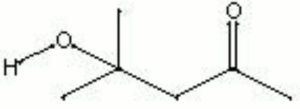Difference between revisions of "Diacetone alcohol"
(username removed) |
(username removed) |
||
| Line 1: | Line 1: | ||
== Description == | == Description == | ||
| − | A strong solvent with a minty odor that can soften dried [http://cameo.mfa.org/materials/fullrecord.asp?name=linseed | + | A strong solvent with a minty odor that can soften dried [http://cameo.mfa.org/materials/fullrecord.asp?name=linseed%20oil linseed oil] films (Mayer 1969). Diacetone alcohol is used as a solvent for [http://cameo.mfa.org/materials/fullrecord.asp?name=cellulose%20nitrate cellulose nitrate], [http://cameo.mfa.org/materials/fullrecord.asp?name=cellulose%20acetate cellulose acetate], [http://cameo.mfa.org/materials/fullrecord.asp?name=oil oils], [http://cameo.mfa.org/materials/fullrecord.asp?name=natural%20resin resin], [http://cameo.mfa.org/materials/fullrecord.asp?name=wax waxes], [http://cameo.mfa.org/materials/fullrecord.asp?name=fat fats], [http://cameo.mfa.org/materials/fullrecord.asp?name=tar tars], [http://cameo.mfa.org/materials/fullrecord.asp?name=lacquer%2C%20synthetic lacquers], [http://cameo.mfa.org/materials/fullrecord.asp?name=dyestuff dyes], and [http://cameo.mfa.org/materials/fullrecord.asp?name=oil%20stain oil stains]. It is also used for preserving wood, leather, and animal tissue and for cleaning metals and textiles. Toch (1931) mentions diacetone alcohol for coalescing crackle on old varnish films. |
== Synonyms and Related Terms == | == Synonyms and Related Terms == | ||
| Line 45: | Line 45: | ||
== Additional Information == | == Additional Information == | ||
| − | R. Mayer, ''A Dictionary of Art Terms and Techniques'', Harper and Row, New York, 1969. | + | ° R. Mayer, ''A Dictionary of Art Terms and Techniques'', Harper and Row, New York, 1969. ° M. Toch, ''Paint, Paintings and Restoration'', D.Van Nostrand, New York, 1931. |
== Authority == | == Authority == | ||
| − | * | + | * R. J. Gettens, G.L. Stout, ''Painting Materials, A Short Encyclopaedia'', Dover Publications, New York, 1966 |
| − | * | + | * G.S.Brady, ''Materials Handbook'', McGraw-Hill Book Co., New York, 1971 Comment: p. 9 |
| − | * | + | * Ralph Mayer, ''A Dictionary of Art Terms and Techniques'', Harper and Row Publishers, New York, 1969 (also 1945 printing) |
* ''The Merck Index'', Martha Windholz (ed.), Merck Research Labs, Rahway NJ, 10th edition, 1983 Comment: entry 3008 | * ''The Merck Index'', Martha Windholz (ed.), Merck Research Labs, Rahway NJ, 10th edition, 1983 Comment: entry 3008 | ||
Revision as of 07:29, 24 July 2013
Description
A strong solvent with a minty odor that can soften dried linseed oil films (Mayer 1969). Diacetone alcohol is used as a solvent for cellulose nitrate, cellulose acetate, oils, resin, waxes, fats, tars, lacquers, dyes, and oil stains. It is also used for preserving wood, leather, and animal tissue and for cleaning metals and textiles. Toch (1931) mentions diacetone alcohol for coalescing crackle on old varnish films.
Synonyms and Related Terms
diacetone; 4-hydroxy-4-methylpentanone-2; pyranton
Other Properties
Miscible with alcohols, aromatics, halogenated hydrocarbons, esters and water.
| Composition | CH3COCH2C(CH3)2OH |
|---|---|
| CAS | 123-42-2 |
| Melting Point | -44 |
| Density | 0.9306 |
| Molecular Weight | mol. wt. = 116.16 |
| Refractive Index | 1.4232 |
| Boiling Point | 167.9 |
Hazards and Safety
Flammable, fire risk. Overexposure may cause irritation of the respiratory system.
Mallinckrodt Baker: MSDS
Additional Information
° R. Mayer, A Dictionary of Art Terms and Techniques, Harper and Row, New York, 1969. ° M. Toch, Paint, Paintings and Restoration, D.Van Nostrand, New York, 1931.
Authority
- R. J. Gettens, G.L. Stout, Painting Materials, A Short Encyclopaedia, Dover Publications, New York, 1966
- G.S.Brady, Materials Handbook, McGraw-Hill Book Co., New York, 1971 Comment: p. 9
- Ralph Mayer, A Dictionary of Art Terms and Techniques, Harper and Row Publishers, New York, 1969 (also 1945 printing)
- The Merck Index, Martha Windholz (ed.), Merck Research Labs, Rahway NJ, 10th edition, 1983 Comment: entry 3008
